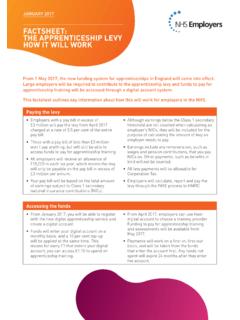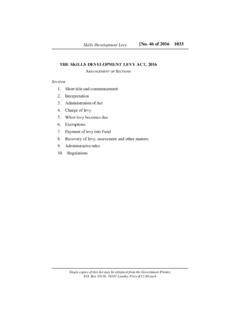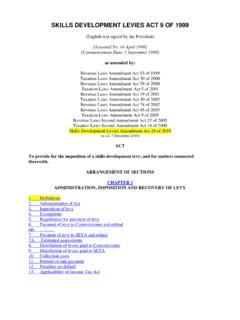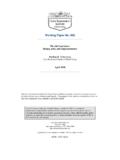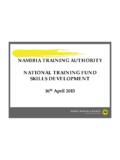Transcription of The Handmaid's Tale[1] - Nebula
1 Nebula , September 2004 Johnson: The Aunts as an Analysis of Feminine 68 The Aunts as an Analysis of Feminine Power in Margaret Atwood s The handmaid s Tale Tara J. Johnson Many scholars, both male and female alike, dismiss the Aunts in Margaret Atwood s The handmaid s Tale as having a token power granted to them by the Commanders in Gilead. In fact, the males in positions of Commanders are given full responsibility for creating and maintaining the Gileadan theocracy many years after the dissolution of Gilead in the novel s blatantly satiric epilogue. Lee Briscoe Thompson in her book Scarlet Letters: Margaret Atwood s The handmaid s Tale believes that lecturer Professor James Darcy Pieixoto s real interest is in the male power elite of Gilead which means that he would dismiss any female involvement (53).
2 Karen Stein in her article Margaret Atwood s Modest Proposal: The handmaid s Tale describes the dystopic Gilead in this manner: In the guise of a re-population program, Gilead reads the biblical text literally and makes it the basis for the state-sanctioned rape, the impregnation ceremony the handmaids must undergo each month (195). The society is obviously founded upon principles that negate the rights of women, which would lead readers to believe that no woman, let alone a group of women, could have the type and the strength of the power of the Commanders. Critics such as Roberta Rubenstein in her article Nature and Nurture in Dystopia: The handmaid s Tale believe that the Aunts only retain power in the puritanical state through their role as indoctrinators of the handmaids (104).
3 This paper would argue that the Aunts were created by Atwood and portrayed in such a manner as to suggest that they have as much if not more power as the Commanders have. Nebula , September 2004 Johnson: The Aunts as an Analysis of Feminine 69 Atwood has a history of placing powerful females in her novels who use their power against other females, and the Aunts in The handmaid s Tale are a clear type of this feminine power. The Aunts fall into the long tradition of females with power in Atwood s novels. Cat s Eye, Atwood s novel immediately following The handmaid s Tale continues this tradition. While most of the criticism concerning Cat s Eye is about Elaine Risley s ability to find her own power (after being tortured by her childhood friend), Cordelia and her treatment of Elaine are reminiscent of the Aunts and their treatment of females, and the handmaids in particular.
4 According to J. Brooks Bouson, The handmaid s Tale anticipates Cat s Eye s dramatization of the female-directed oppression of women (which begins during the girlhood socialization process) and it describes the brutal reeducation of the Handmaids, who are coerced by the Aunts to forego the ideology of women s liberation and to revert to the traditional values of a male-dominated system (141). Atwood intentionally created the Aunts as powerful females in a dystopia. In a radio conversation with fellow writer Victor-Levy Beaulieu, she said that the character of Aunt Lydia is based on the history of imperialisms. For example, the British in India raised an army of Indians to control the rest of the , if you want to control women, you have to grant some women a tiny bit more power so that they ll control the others (Atwood and Beaulieu 78).
5 In a BBC World Book Club radio program last year, Margaret Atwood stated: I think the Aunts [in The handmaid s Tale] have quite a bit of , they would have to answer to a top level of men (4 Aug. 2003). And during Professor Pieixoto s examination of the Gileadan theocracy in the novel s epilogue, he clearly notes Atwood s observation: Nebula , September 2004 Johnson: The Aunts as an Analysis of Feminine 70 Judd according to the Limkin material was of the opinion from the outset that the best and most cost-effective way to control through women themselves. For this there were many historical precedents; in fact, no empire imposed by force or otherwise has ever been without this feature: control of the indigenous members by their own group (390).
6 By taking this power offered to them, the Aunts were therefore able to escape redundancy, and consequent shipment to the infamous Colonies, which were composed of portable populations used mainly as expendable toxic-cleanup squads, though if lucky could be assigned to less hazardous tasks, such as cotton picking and fruit harvesting (390-91). According to Thompson, it is the pleasures of power that seal the deal along with the small perks and personal security. Thompson claims the Aunts to be a classic depiction of Victim Position #1 as described in Atwood s analysis of victimhood in her literary study Survival (51). While the Aunts may be victims of a male hierarchy, they certainly choose to utilize the power that they have over other women.
7 Linda Myrsiades in her article Law, Medicine, and the Sex Slave in Margaret Atwood s The handmaid s Tale simply categorizes the Aunts as a class of women assigned to educate the handmaids to their roles as surrogates (227). David Coad in his article Hymens, Lips and Masks: The Veil in Margaret Atwood s The handmaid s Tale limits the role of the Aunts by saying that they are merely sadistic propagandists (54). It could be argued, however, that the Aunts are responsible for sustaining the rituals of the Gileadan society, and not only the training of the Handmaids at the Rachel and Leah Reeducation Center. When Janine, or Ofwarren, is ready to give birth, Aunt Elizabeth Nebula , September 2004 Johnson: The Aunts as an Analysis of Feminine 71 plays an integral part in the birthing process for both Janine and the Commander s wife (158-62).
8 At the assembly of the Handmaids, Aunt Lydia directs both the Salvaging and the Particicution ceremonies (352-60). Lucy M. Freibert in her article Control and Creativity: The Politics of Risks in Margaret Atwood s The handmaid s Tale describes both ceremonies in this manner: At the hangings each handmaid must touch the rope in assent to the murders. At Particicutions the Handmaids ritually dismember any man accused of rape. The Aunts supply the rhetoric that arouses the women to savagery (284-85). The Aunts are also responsible for directing the females who are not Handmaids. When Offred goes with the Commander to the club, which serves as a brothel for the Commanders, she is surprised to see that an Aunt is responsible for regulating the behavior of her friend Moira and the other prostitutes.
9 The Aunt determines when the prostitutes take their breaks and for how long the breaks are (313). The Aunt also determines whether they need to lose weight in their positions and will punish them if they are overweight (309). A comparison of the Aunts responsibility and the Commanders responsibility shows that the Commanders are in charge of much lighter duties. A Commander officiates the arranged marriages service (282-83). The Commander is responsible for reading Bible passages to his household (114). The Commander is also responsible for impregnating the handmaid in order to continue Gilead (122). It is clear that that the Aunts have more responsibilities in the Gileadan theocracy than merely educating women for service as Handmaids.
10 Most scholarly criticism focuses on the Aunts responsibility for maintaining the Rachel and Leah Reeducation Center. According to Barbara Hill Rigney in her book Margaret Atwood, the control agency in this novel is, not the commanders, but the Nebula , September 2004 Johnson: The Aunts as an Analysis of Feminine 72 Aunts , who run their re-education centres with cattle prods, torture techniques, and brain washing slogans (118). The Aunts have very clear goals that they want to accomplish with their training of the Handmaids. The first is to delete the women from history: All official records of the handmaids would have been destroyed upon their entry into the Rachel and Leah Re-education Center (387).




